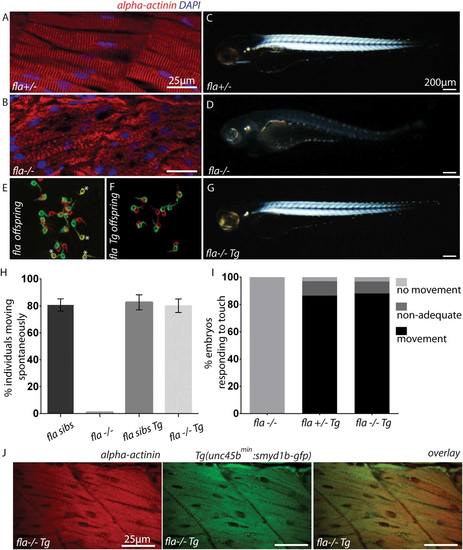- Title
-
A compact unc45b-promoter drives muscle-specific expression in zebrafish and mouse
- Authors
- Rudeck, S., Etard, C., Khan, M.M., Rottbauer, W., Rudolf, R., Strähle, U., Just, S.
- Source
- Full text @ Genesis
|
A small 195 bp unc45b promoter fragment drives cardiac and skeletal muscle expression. (A) Schematic representation of the full-length unc45b promoter 1.8(unc45b:tfp), a 195 bp unc45b promoter fragment associated with gata2 (unc45bmingata2:gfp) and the 195 bp unc45b promoter fragment alone (unc45bmin:gfp). (B) Injection of unc45bmingata2:gfp into wild-type embryos reveals GFP expression within cardiac and skeletal muscle (72 hpf). (C) Transgenic unc45bmingata2:gfp embryos Tg(unc45bmingata2:gfp) show a restricted expression in skeletal and cardiac muscles at 72 hpf. (D) Microinjection of unc45bmin:tfp into wild-type embryos also reveals a restricted expression in skeletal and cardiac muscles (72 hpf). (E) Tg(unc45bmin:gfp) transgenic zebrafish embryos show heart- and skeletal muscle-specific GFP expression (72 hpf). (F, G) Heat shock significantly increases GFP levels in Tg(unc45bmin:gfp) embryos (G) compared to untreated embryos (F) at 72 hpf. EXPRESSION / LABELING:
|
|
The transgenic zebrafish line Tg(unc45bmin:smyd1b-gfp) exhibits Smyd1b expression specifically within cardiac and skeletal muscles. (A, B) At 72 hpf, Tg(unc45bmin:smyd1b-gfp) transgenic embryos show strong and restricted expression of Smyd1b-GFP fusion proteins within heart and skeletal muscles. A (Atrium), V (Ventricle). (C) α-actinin-specific immunostaining of Tg(Uncmin45b:smyd1b-gfp) transgenic embryos reveals an alternating distribution of Smyd1b-GFP and α-actinin, suggesting Smyd1b localization at the sarcomeric M-line (72 hpf). (D, E) smyd1b-gfp expression was significantly enhanced by 1 h heat shock of the transgenic line Tg(unc45bmin:smyd1b-gfp) (E) compared to untreated transgenic embryos (D) at 72 hpf. EXPRESSION / LABELING:
PHENOTYPE:
|
|
Functional and structural rescue of fla mutant embryos by the transgenic reintroduction of Smyd1b. (A, B) Immunostaining of fla siblings (A) and mutants (B) with α-actinin-specific antibodies (red) and DAPI (blue). Normal sarcomeric striation was visible in siblings, whereas complete lack of sarcomeric organization was found in homozygous fla mutant embryos. (C, D) fla siblings show strong birefringence signals at 72 hpf (C) whereas fla mutants lack proper sarcomeric organization and thereby birefringence signal (D). (E, F) Representative overview of spontaneous movement assays (at 24 hpf) with false-colored and superimposed pictures of fla offspring derived from intercrossing heterozygous fla fish. Genotyping of these embryos revealed that all non-moving (yellow*) embryos are homozygous fla mutants (E). By contrast, all homozygous fla mutant embryos carrying the transgene (Tg(unc45bmin:smyd1b-gfp)) are able to move (F) (red to green shift). Red pictures 0 s, green pictures 10 s. (G) Transgenic reintroduction of Smyd1b (Tg(unc45bmin:smyd1b-gfp)) into homozygous fla mutant embryos leads to normal birefringence signal. (H) Statistical analysis of the spontaneous movement assay. 80 ± 3.6% of genotyped fla siblings (fla+/+ and fla+/-) showed normal motility after 24 hpf (n = 111; three independent experiments). By contrast, homozygous fla mutant embryos are completely paralyzed (n = 35; three independent experiments). In comparison, 82.7 ± 5.6% of fla sibs (fla+/+ and fla+/-) (n = 98; three independent experiments) and 80.7 ± 4.6% of homozygous fla mutants carrying the transgene that expresses smyd1b showed normal spontaneous movements (n = 32; three independent experiments). Error bars indicate sd. (I) Quantification of the touch-evoked flight response at 72 hpf. Homozygous fla mutants are completely paralyzed and do not flight upon tactile stimulation (n = 47; three independent experiments). 86.6% of fla siblings (fla+/+ and fla+/-) carrying the transgene (n = 61; three independent experiments) show regular motility at 72 hpf. Similarly, 88.2% of homozygous fla mutant embryos carrying the transgene (n = 26; three independent experiments) are able to respond regularly upon tactile stimulation. (J) α-actinin-specific immunostainings of skeletal muscles reveal normal sarcomeres in fla mutants carrying Tg(unc45bmin:smyd1b-gfp), indicating a complete structural rescue by the transgenic reintroduction of Smyd1b in homozygous fla mutants. EXPRESSION / LABELING:
PHENOTYPE:
|



